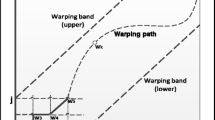Abstract
Recognition of sleep and wake states is one of the relevant parts of sleep analysis. Performing this measurement in a contactless way increases comfort for the users. We present an approach evaluating only movement and respiratory signals to achieve recognition, which can be measured non-obtrusively. The algorithm is based on multinomial logistic regression and analyses features extracted out of mentioned above signals. These features were identified and developed after performing fundamental research on characteristics of vital signals during sleep. The achieved accuracy of 87% with the Cohen’s kappa of 0.40 demonstrates the appropriateness of a chosen method and encourages continuing research on this topic.
Access this chapter
Tax calculation will be finalised at checkout
Purchases are for personal use only
Similar content being viewed by others
Notes
- 1.
Initial study was carried out in the Interdisciplinary Center for Sleep Medicine of Charité-Universitätsmedizin Berlin, Charitéplatz 1, D-10117 Berlin (Germany).
References
Mukherjee, S., et al.: An official american thoracic society statement: the importance of healthy sleep. Recommendations and future priorities. Am. J. Respir. Crit. Care Med. 191, 1450–1458 (2015)
Lao, X.Q., et al.: Sleep quality, sleep duration, and the risk of coronary heart disease: a prospective cohort study with 60,586 adults. J. Clin. Sleep Med. 14, 109–117 (2018)
Grandner, M., Mullington, J.M., Hashmi, S.D., Redeker, N.S., Watson, N.F., Morgenthaler, T.I.: Sleep duration and hypertension: analysis of 700,000 adults by age and sex. J. Clin. Sleep Med. 14, 1031–1039 (2018)
Chaput, J.-P., et al.: Sleep duration and health in adults: an overview of systematic reviews. Appl. Physiol. Nutr. Metab. 45, S218–S231 (2020)
Gaiduk, M., Seepold, R., Ortega, J.A., Martínez Madrid, N.: Comparison of sleep characteristics measurements: a case study with a population aged 65 and above. Procedia Comput. Sci. 176, 2341–2349 (2020)
Gaiduk, M., et al.: A comparison of objective and subjective sleep quality measurement in a group of elderly persons in a home environment. In: Saponara, S., De Gloria, A. (eds.) ApplePies 2020. LNEE, vol. 738, pp. 286–291. Springer, Cham (2021). https://doi.org/10.1007/978-3-030-66729-0_35
Schokman, A., et al.: Agreement between subjective and objective measures of sleep duration in a low-middle income country setting. Sleep Health 4, 543–550 (2018)
Lauderdale, D.S., Knutson, K.L., Yan, L.L., Liu, K., Rathouz, P.J.: Self-reported and measured sleep duration: how similar are they? Epidemiol. (Cambridge, Mass.) 19, 838–845 (2008)
Matthews, K.A., et al.: Similarities and differences in estimates of sleep duration by polysomnography, actigraphy, diary, and self-reported habitual sleep in a community sample. Sleep Health 4, 96–103 (2018)
Short, M.A., Gradisar, M., Lack, L.C., Wright, H., Carskadon, M.A.: The discrepancy between actigraphic and sleep diary measures of sleep in adolescents. Sleep Med. 13, 378–384 (2012)
Kryger, M.H., Roth, T., Dement, W.C.: Principles and Practice of Sleep Medicine. Elsevier, Philadelphia (2005)
Berry, R.B., Quan, S.F., Abreu A.R., et.al: The AASM manual for the scoring of sleep and associated events. Rules, terminology and technical specifications: Version 2.6. American Academy of Sleep Medicine, Darien, Illinois (2020)
Hirshkowitz, M.: Polysomnography challenges. Sleep Med. Clin. 11, 403–411 (2016)
Gaiduk, M., Seepold, R., Martínez Madrid, N., Orcioni, S., Conti, M.: Recognizing breathing rate and movement while sleeping in home environment. In: Saponara, S., De Gloria, A. (eds.) ApplePies 2019. LNEE, vol. 627, pp. 333–339. Springer, Cham (2020). https://doi.org/10.1007/978-3-030-37277-4_38
Gaiduk, M., Wehrle, D., Seepold, R., Ortega, J.A.: Non-obtrusive system for overnight respiration and heartbeat tracking. Procedia Comput. Sci. 176, 2746–2755 (2020)
Gaiduk, M., Vunderl, B., Seepold, R., Ortega, J.A., Penzel, T.: Sensor-mesh-based system with application on sleep study. In: Rojas, I., Ortuño, F. (eds.) IWBBIO 2018. LNCS, vol. 10814, pp. 371–382. Springer, Cham (2018). https://doi.org/10.1007/978-3-319-78759-6_34
Pai, F.-Y., Huang, K.-I.: Applying the technology acceptance model to the introduction of healthcare information systems. Technol. Forecast. Soc. Chang. 78, 650–660 (2011)
Kurihara, Y., Watanabe, K.: Sleep-stage decision algorithm by using heartbeat and body-movement signals. IEEE Trans. Syst., Man, Cybern. A 42, 1450–1459 (2012)
Gaiduk, M., Penzel, T., Ortega, J.A., Seepold, R.: Automatic sleep stages classification using respiratory, heart rate and movement signals. Physiol. Measur. 39, 124008 (2018)
Hosmer, D.W., Lemeshow, S., Sturdivant, R.X.: Applied Logistic Regression. Wiley, New York (2013)
Greene, W.H.: Econometric analysis. Pearson Education, Boston (2012)
Long, X., Foussier, J., Fonseca, P., Haakma, R., Aarts, R.M.: Analyzing respiratory effort amplitude for automated sleep stage classification. Biomed. Signal Process. Control 14, 197–205 (2014)
Fleiss, J.L., Levin, B., Paik, M.C., Shewart, W.A., Wilks, S.S.: Statistical Methods for Rates and Proportions. John Wiley & Sons Inc., Hoboken (2003)
Acknowledgments
We thank the Interdisciplinary Center for Sleep Medicine of Charité Clinic in Berlin and, in particular, Dr. rer. medic. Martin Glos for supporting the study.
This research was partially funded by the EU Interreg V-Program “Alpenrhein-Bodensee-Hochrhein”: Project “IBH Living Lab Active and Assisted Living”, grants ABH40, ABH41, and ABH66 and by the German Federal Ministry For Economic Affairs And Energy, ZiM project “Sleep Lab at Home” (SLaH) grant: ZF4825301AW9.
Author information
Authors and Affiliations
Corresponding author
Editor information
Editors and Affiliations
Rights and permissions
Copyright information
© 2022 The Author(s), under exclusive license to Springer Nature Switzerland AG
About this paper
Cite this paper
Gaiduk, M. et al. (2022). Evaluating Body Movement and Breathing Signals for Identification of Sleep/Wake States. In: Saponara, S., De Gloria, A. (eds) Applications in Electronics Pervading Industry, Environment and Society. ApplePies 2021. Lecture Notes in Electrical Engineering, vol 866. Springer, Cham. https://doi.org/10.1007/978-3-030-95498-7_29
Download citation
DOI: https://doi.org/10.1007/978-3-030-95498-7_29
Published:
Publisher Name: Springer, Cham
Print ISBN: 978-3-030-95497-0
Online ISBN: 978-3-030-95498-7
eBook Packages: EngineeringEngineering (R0)




